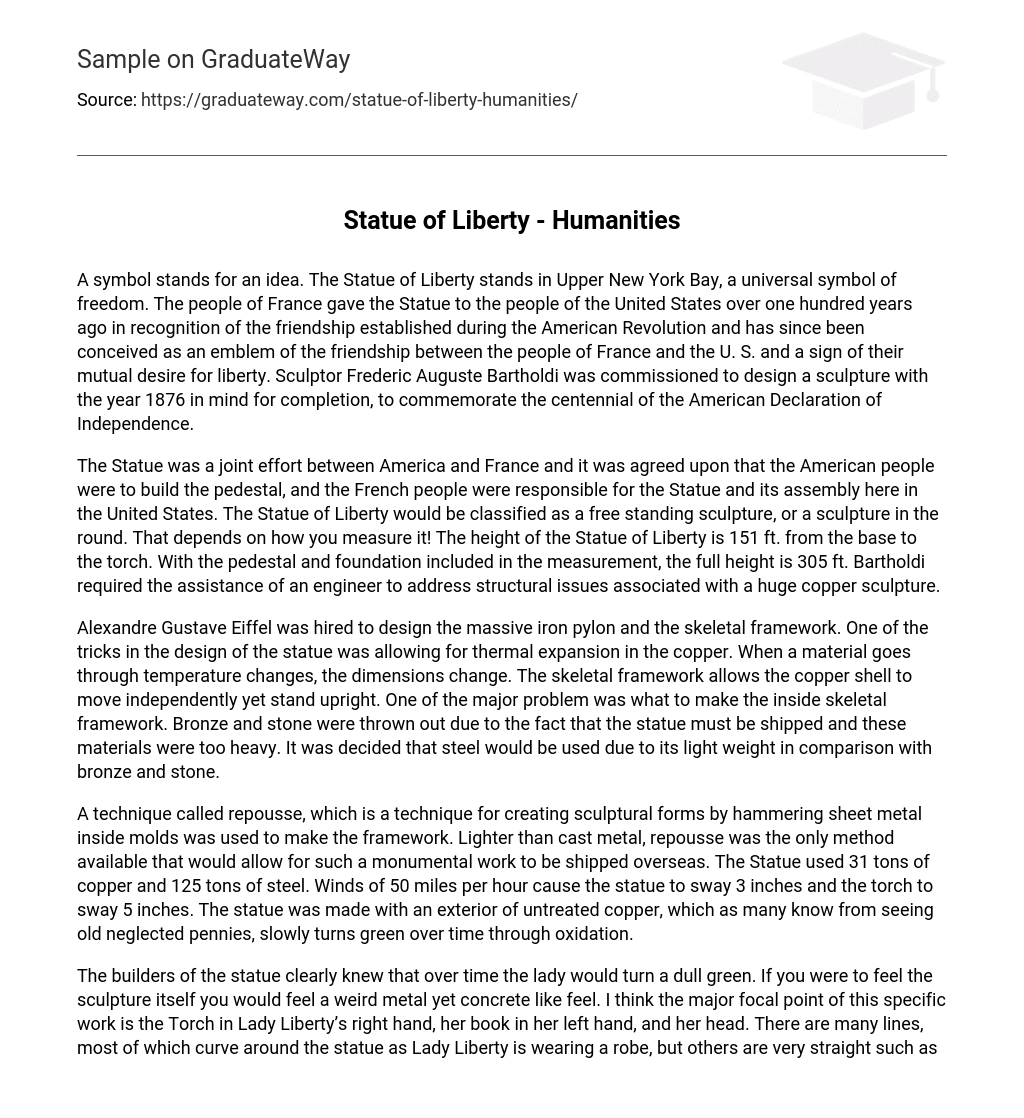A symbol stands for an idea. The Statue of Liberty stands in Upper New York Bay, a universal symbol of freedom. The people of France gave the Statue to the people of the United States over one hundred years ago in recognition of the friendship established during the American Revolution and has since been conceived as an emblem of the friendship between the people of France and the U. S. and a sign of their mutual desire for liberty. Sculptor Frederic Auguste Bartholdi was commissioned to design a sculpture with the year 1876 in mind for completion, to commemorate the centennial of the American Declaration of Independence.
The Statue was a joint effort between America and France and it was agreed upon that the American people were to build the pedestal, and the French people were responsible for the Statue and its assembly here in the United States. The Statue of Liberty would be classified as a free standing sculpture, or a sculpture in the round. That depends on how you measure it! The height of the Statue of Liberty is 151 ft. from the base to the torch. With the pedestal and foundation included in the measurement, the full height is 305 ft. Bartholdi required the assistance of an engineer to address structural issues associated with a huge copper sculpture.
Alexandre Gustave Eiffel was hired to design the massive iron pylon and the skeletal framework. One of the tricks in the design of the statue was allowing for thermal expansion in the copper. When a material goes through temperature changes, the dimensions change. The skeletal framework allows the copper shell to move independently yet stand upright. One of the major problem was what to make the inside skeletal framework. Bronze and stone were thrown out due to the fact that the statue must be shipped and these materials were too heavy. It was decided that steel would be used due to its light weight in comparison with bronze and stone.
A technique called repousse, which is a technique for creating sculptural forms by hammering sheet metal inside molds was used to make the framework. Lighter than cast metal, repousse was the only method available that would allow for such a monumental work to be shipped overseas. The Statue used 31 tons of copper and 125 tons of steel. Winds of 50 miles per hour cause the statue to sway 3 inches and the torch to sway 5 inches. The statue was made with an exterior of untreated copper, which as many know from seeing old neglected pennies, slowly turns green over time through oxidation.
The builders of the statue clearly knew that over time the lady would turn a dull green. If you were to feel the sculpture itself you would feel a weird metal yet concrete like feel. I think the major focal point of this specific work is the Torch in Lady Liberty’s right hand, her book in her left hand, and her head. There are many lines, most of which curve around the statue as Lady Liberty is wearing a robe, but others are very straight such as the ones found on the torch going vertically. There are also lines to detail her hair that is shown between her head and her hat, The Statue of Liberty is a true marble to see.
It doesn’t have one clear significance, but many in the eyes of those who see it. To Americans, it does mean freedom. During the 19th century, when immigrants from Europe were flooding through Ellis Island, the first truly American entity they saw was the Statue of Liberty. For them, it symbolized the American Dream, and how even they had the opportunity to make it big. This makes me really think about how easy I have it, having been born in a middle class family I don’t appreciate the simple things like clean water, a place for shelter, a place to call home and sleep.
Some people just don’t have the comfort of these things that to us may seem like necessities but to others may be commodities. It is also the freedom of spirit and of choice that was declared an inalienable right in the Declaration of Independence – a document whose date of execution, July 4th, 1776, is inscribed on the tablet she carries. The Statue welcomes all to this door – the lost, the needy, the rejected, and the exiled. She invites them to step through it into freedom.
Service, National Park . “History of The Statue of Liberty.” Statue of Liberty. 1 May. 2009.<http://statueofliberty.org/Statue_History.html>. University, Purdue . Purdue University- Statue Of Liberty. 14 Dec. 2012.<https://engineering.purdue.edu/MSE/AboutUs/GotMaterials/Parks/thomas.html>.





